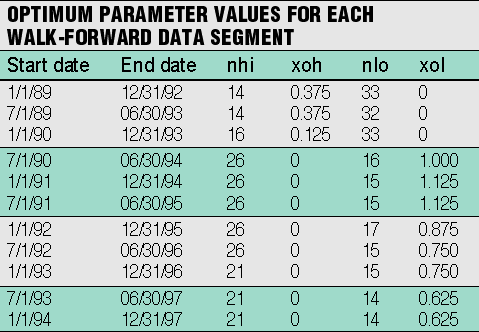SYSTEM DESIGN
by Dennis Meyers, Ph.D.
Here's how to develop a system using a filter to remove the random price movement and identify the trend of the Treasury bond market.
The US Treasury bond futures contract is one of the most active exchange-traded futures contracts in the world. The US Treasury bond future is traded on the Chicago Board of Trade (CBT) and it is used by major banks, institutions, and trading firms to hedge their bond portfolios and their associated derivative products. The bond futures are traded from 7:20 am to 2 pm on the CBT and from 2:30 pm to 6:45 am on the CBT Project A system. The trading volume of the US Treasury bond futures contract is sizable, and arbitrage keeps the futures prices in line with the even larger over-the-counter Treasury bond market.
DATA DISCUSSION
The bond futures contract on the CBT trades in the quarterly cycles of March, June, September and December. The current active US futures contract as of this writing is the US September 1998. The September 1998 contract's last trading day will be on the seventh business day preceding the last business day of September 1998. The US December 1998 contract will become the active contract on the first business day before September 1, 1998.
Each bond futures contract is worth the dollar value of the quoted price multiplied by $1,000. On May 22, 1998, the US September 1998 closed at 120-16/32, making the US September 1998 futures contract worth $120,500 (120.50 * $1,000). The bond futures contract's smallest tick size is 1/32 of a point, and thus, a move of one tick is worth $31.25 per contract (0.03125 * $1,000 = $31.25).
The US Treasury bond futures started trading in 1977, but for the purposes of this article, we will limit our study to the price history from January 1, 1989, to May 1, 1998. In addition, we will only use the prices from the day-session traded bond futures contract ? that is, the prices generated by open outcry on the CBT trading floor from 7:20 am CST to 2:00 pm CST. We will use a US Treasury bond futures continuous contract, since the US Treasury bond futures contracts expire each quarter. A continuous contract is constructed by switching to the active contract on the rollover day and back-adjusting the difference in prices between the new contract and the old, thus creating a smooth continuous contract.
The performance results from systems using continuous contracts cannot match actual results from trading real contracts. This is due to the costs of actually having to roll over, as well as execution slippage. Execution slippage is the difference in prices from actually executing an order when a buy or sell signal is given and the price at which the computer system assumes that the order was executed. When rolling over, the difference in prices between the new contract and the old on rollover day may not be the same as the closing prices that are used to construct the continuous contract.
